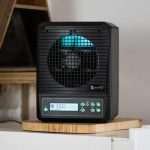Why is Indoor Air Quality Important?
Every year at least 6,000 new chemical compounds are developed. Sweetwater’s Air Purifiers can remove many of these from indoor air.
Many are used indoors every day, at home and at work. Add to these pollutants the mold, mildew, bacteria, viruses, tobacco smoke, grease, pollen, dirt, asbestos, lead and numerous other contaminants that can affect our breathing and our health. Then allow them to circulate in today’s nearly airtight indoor environment. No wonder our indoor air is, on average, two to ten times as polluted as the worst outdoor air.
Viruses and bacteria that thrive in the ducts, coils, and recesses of building ventilation systems have been proven to cause ailments ranging from influenza to tuberculosis. Some HVAC systems have been found to contain up to 27 species of fungi.
Based on information given at the First Annual Air Quality convention sponsored by EPA, April 1992, Tampa, Florida:
• 40% of all buildings pose a serious health hazard due to indoor air pollution, according to the World Health Organization.
• EPA estimates an 18% annual production loss to American business due to poor indoor air quality.
• 20% of all employees have a major illness related to indoor air pollution such as allergies, asthma, auto-immune diseases, etc.
• EPA says high levels of formaldehyde cause cancer. Those air fresheners that you buy in your grocery store, the little plug in type, give off formaldehyde.
• Scientists now recognize that pollutants, even at acceptable concentration, combined together in an indoor environment have a synergistic negative effect.
Negative Ions Pollutants and Health
Ionization or negative ion generation is often referred to as the “thunderstorm effect”. It is well known that prior to a thunderstorm, animals and even many humans feel nervous, jittery and irritable; however, after the storm there seems to be a feeling of calm. Both animals and humans experience this phenomena. Most people can not explain this renewed sense of well-being. However, there is a logical explanation. All of this is due to the amount of negative ions in the air around us. Prior to a thunderstorm there is a very high concentration of positive ions in the air. These tend to be pollutants such as dust, bacteria, pollen, chemicals, etc. The storm releases electrical discharges consisting of high concentrations of negative ions. Negative ions destroy many of these air pollutants and, therefore, give us a sense of well being. When relatively too many positive ions are present in the air before a storm, the positive charge is transferred in the air you breathe from your lungs to the blood, causing the blood platelets to release a hormone that quite strongly affects your moods, your joints, and other physiological functions in your body.
Ions are floating in the air around us all the time and have either negative or positive charges on them. Changes in their concentration, or in the ratio of positively to negatively charged molecules can have remarkable effects on plants and animals. It is known in science that ion depletion is the source of a wide range of human health problems, both mental and physical. Air ions are important to you because if there are a high proportion of negative ions you will feel lively, uplifted, and enthusiastic. Too many positive ions will have you feeling depressed, lethargic and full of aches, pains and complaints. In general, exposure to negatively ionized air has been shown to increase oxygenation of the lungs, vital capacity, and ciliary activity. All types of beneficial responses take place as a result of these friendly ions.
Instead of trying to change the way your body responds to irritants—that’s how most asthma and allergy meds work—go after the irritants directly. Whole-house air filters and even portable units can significantly reduce the triggers that cause your wheezing, chest tightness, and coughing, says Ted Myatt, Sc.D., a senior scientist at the consulting firm Environmental Health and Engineering, near Boston. His 2008 study in Environmental Health found that high-efficiency in-duct air filters reduced cat allergens by up to 55 percent and fungal spores by up to 75 percent. If you combine a HEPA filter in your air ducts with an ion generating air purifier you can reduce airborne particulate even further.
Fortunately through modern technology it is possible to control the electrical state of our indoor environments by generating negative ions back in the air. These negative ions attach themselves to airborne toxins and drop them to a surface. Ions basically take out the larger pollutants in the air. For example, ozone will eliminate the smell of smoke in the room and neutralize the chemicals. Negative ions remove the smoke itself.
The use of ozone indoors is often criticized by some in the environmental community. I personally find ozone to be an effective and safe oxidant when used in accordance with the instructions Here’s a very well written about ozone: http://www.understandingozone.com/article_response.asp
To learn more, visit:
Sweetwater’s Indoor Air Purifiers
or call now to order: 866-691-4214 (9 AM – 6 PM MST)







Poor air quality due to airborne chemicals and poor ventilation is often an issue in office environments as well. And given that full-time workers spend a major part of each day in their place of work, it makes good business sense for an employer to take steps to improve office air quality with one of the quality air purifiers.